A Bibliometric Analysis of the Research on Electromobility and Its Implications for Kuwait
Abstract
1. Introduction
1.1. Energy Efficiency of Electric Vehicles vs. Internal Combustion Engine Cars
1.2. Other Benefits of EVs over ICE Vehicles
1.3. Reasons for Low EV Adoption Rates in Emerging Markets
2. Methodology
2.1. What Is Bibliometric Analysis?
2.2. VOX-Viewer Methodology
TITLE (electric AND vehicle) AND PUBYEAR > 2000 AND (LIMIT-TO (SUBJAREA, “ENER”)) AND (LIMIT-TO (LANGUAGE, “English”)) AND (LIMIT-TO (EXACTKEYWORD, “Electric Vehicle”) OR LIMIT-TO (EXACTKEYWORD, “Charging (batteries)”))
TITLE (electric AND vehicle) AND PUBYEAR > 2000 AND (LIMIT-TO (SUBJAREA, “ENER”)) AND (LIMIT-TO (LANGUAGE, “English”)) AND (LIMIT-TO (EXACTKEYWORD, “Electric Vehicle”) OR LIMIT-TO (EXACTKEYWORD, “Charging (batteries)”)).
Variants tested (not used in the final run): adding EXACTKEYWORD(“battery electric vehicle”) and EXACTKEYWORD(“fast charging”). Exclusions: duplicates, editorials, non-English.
3. Results and Discussion
3.1. Cluster Analysis
3.2. Cluster 1: Charging Station
3.3. Cluster 2: Battery Management Systems
3.4. Cluster 3: Vehicle–Grid Integration
3.5. Cluster 4: Battery Swapping and Logistics
3.6. Cluster 5: Wireless Charging
3.7. Cluster 6: Renewable Energy
3.8. Summary of the Cluster Analysis
4. Takeaways for Countries with Emerging Markets, Such as the State of Kuwait
4.1. The Most Researched Topics in the Kuwaiti Context: Charging States and Battery Performance
4.2. Variations in Performance with Seasons
4.3. Variations in Charging Time in Different Seasons
4.4. Wireless Power Transfer for EVs vs. Cooling Constraints at Charging Stations in Kuwait
4.5. Renewable Energy-Supported Vehicle–Grid Integration (VGI)
4.6. Battery Swapping
4.7. Environmental Impact of Driving an EV
4.8. Environmental Life-Cycle Impact
4.9. Limitations and Scope
5. Conclusions
Author Contributions
Funding
Institutional Review Board Statement
Informed Consent Statement
Data Availability Statement
Acknowledgments
Conflicts of Interest
Abbreviations
| BA | Bibliometric analysis |
| BMS | Battery management system |
| CAPEX | Capital expenditure |
| DCFC | Direct current fast charging |
| DEVC | Dynamic electric vehicle charging |
| EV | Electric vehicle |
| G2V/V2G | Grid to vehicle/vehicle to grid |
| GHG | Greenhouse gas |
| ICE | Internal combustion engine |
| LIB | Lithium-ion battery |
| OPEX | Operating expenditure |
| RES | Renewable energy source |
Appendix A. Mapping of Bibliometric Clusters to Kuwaiti EV Adoption Barriers
| Cluster (Section 3) | Dominant Keyword Themes | Kuwaiti Survey Factor (¼ of the Ten Reasons Listed in Section 1.3) | Brief Explanation |
| Charging stations and infrastructure | charging station, corridor hyper-hubs | “Lack of public charging sites” | Research focuses on siting and hub design, matching the “no places to charge” concern. |
| Battery management and health | state of health, aging models | “Battery replacement cost” | Health prediction and life extension papers target the fear of cost. |
| Vehicle–grid integration | V2G, tariff design | “High electricity tariff” | Cluster research shows bidirectional pricing schemes. |
| Battery swapping and logistics | swap stations, taxi trials | “Long charging time/waiting” | Battery swaps remove dwell time entirely. |
| Wireless charging | inductive pads, EMF limits | “Safety of charging technology” | EMF compliance and sand ingress tests speak to safety. |
| Renewable energy coupling | PV carports, micro-grids | “High well-to-wheel emissions” | Papers quantify GHG cuts from PV-coupled charging. |
References
- International Energy Agency. Global EV Outlook 2022: Securing Supplies for an Electric Future; OECD Publishing: Paris, France, 2022. [Google Scholar] [CrossRef]
- Apostolaki-Iosifidou, E.; Codani, P.; Kempton, W. Measurement of power loss during electric vehicle charging and discharging. Energy 2017, 127, 730–742. [Google Scholar] [CrossRef]
- Conti, M.; Kotter, R.; Putrus, G. Energy Efficiency in Electric and Plug-in Hybrid Electric Vehicles and Its Impact on Total Cost of Ownership. In Electric Vehicle Business Models Lecture Notes in Mobility; Springer: Cham, Switzerland, 2015. [Google Scholar] [CrossRef]
- Chan, C.C.; Wong, Y.S. The State of the Art of Electric-Vehicle Technology. In Proceedings of the 4th International Power Electronics and Motion Control Conference, Xi’an, China, 14–16 August 2004; pp. 46–57. [Google Scholar]
- Beeton, D.; Meyer, G. (Eds.) Electric Vehicle Business Models: Global Perspectives; Springer International Publishing: Cham, Switzerland, 2015. [Google Scholar] [CrossRef]
- Coignard, J.; Saxena, S.; Greenblatt, J.; Wang, D. Clean vehicles as an enabler for a clean electricity grid. Environ. Res. Lett. 2018, 13, 054031. [Google Scholar] [CrossRef]
- Machín, A.; Márquez, F. The Next Frontier in Energy Storage: A Game-Changing Guide to Advances in Solid-State Battery Cathodes. Batteries 2023, 10, 13. [Google Scholar] [CrossRef]
- Wood, J. Electric vehicles: The 3 main factors holding back sales. World Economic Forum. 26 October 2022. Available online: https://www.weforum.org/stories/2022/10/ev-sales-charging-infrastructure-transport-sector-sustainable/ (accessed on 14 June 2024).
- Dudziak, A.; Caban, J.; Stopka, O.; Stoma, M.; Sejkorová, M.; Stopková, M. Vehicle Market Analysis of Drivers’ Preferences in Terms of the Propulsion Systems: The Czech Case Study. Energies 2023, 16, 2418. [Google Scholar] [CrossRef]
- 4 Reasons Why Electric Cars Haven’t Taken Off Yet, World Econ. Forum—Energy Transit. 2021. Available online: https://www.weforum.org/agenda/2021/07/electric-cars-batteries-fossil-fuel/ (accessed on 12 March 2024).
- Yoon, K.; Kim, H.; Han, S.; Chan, T.S.; Ko, K.H.; Jo, S.; Park, J.; Kim, S.; Lee, S.; Noh, J.; et al. Detrimental Effect of High-Temperature Storage on Sulfide-Based All-Solid-State Batteries. Appl. Phys. Rev. 2022, 9, 031403. [Google Scholar] [CrossRef]
- Turan, F.K. Policy incentives versus purchase-price elasticity in emerging EV markets. Transp. Policy 2024, 148, 192–205. [Google Scholar] [CrossRef]
- Alasseri, R.; Rao, T.J.; Sreekanth, K.J. Pre-implementation assessment for introducing direct load control strategies in the residential electricity sector. Int. J. Energy Environ. Eng. 2021, 12, 433–451. [Google Scholar] [CrossRef]
- Alasseri, R.; Rao, T.J.; Sreekanth, K.J. Institution of incentive-based demand response programs and prospective policy assessments for a subsidized electricity market. Renew. Sustain. Energy Rev. 2020, 117, 109490. [Google Scholar] [CrossRef]
- Ottesen, A.; Navfal, M.; Hamwi, H.; Kous, A.A. Kuwaiti EV Owners’ Experience and Recommendations for Mass Adoption for the World’s EV Laggard. World Electr. Veh. J. 2025, 16, 117. [Google Scholar] [CrossRef]
- Ottesen, A.; Banna, S.; Alzougool, B. Attitudes of Drivers towards Electric Vehicles in Kuwait. Sustainability 2022, 14, 12163. [Google Scholar] [CrossRef]
- Ottesen, A.; Banna, S.; Alzougool, B. How to Cross the Chasm for the Electric Vehicle World’s Laggards—A Case Study in Kuwait. World Electr. Veh. J. 2023, 14, 45. [Google Scholar] [CrossRef]
- Ottesen, A.; Banna, S.; Alzougool, B. Women Will Drive the Demand for EVs in the Middle East over the Next 10 Years—Lessons from Today’s Kuwait and 1960s USA. Energies 2023, 16, 3756. [Google Scholar] [CrossRef]
- Ottesen, A.; Thom, D.; Bhagat, R.; Mourdaa, R. Learning from the Future of Kuwait: Scenarios as a Learning Tool to Build Consensus for Actions Needed to Realize Vision 2035. Sustainability 2023, 15, 7054. [Google Scholar] [CrossRef]
- Banna, S.; Ottesen, A.; Alzougool, B. Reasons Why Only Kuwaiti Citizens Drive Electric Vehicles despite Being Only a Quarter of the Population. World Electr. Veh. J. 2023, 14, 287. [Google Scholar] [CrossRef]
- Donthu, N.; Kumar, S.; Mukherjee, D.; Pandey, N.; Lim, W.M. How to conduct a bibliometric analysis: An overview and guidelines. J. Bus. Res. 2021, 133, 285–296. [Google Scholar] [CrossRef]
- Bouzembrak, Y.; Klüche, M.; Gavai, A.; Marvin, H.J.P. Internet of Things in food safety: Literature review and a bibliometric analysis. Trends Food Sci. Technol. 2019, 94, 54–64. [Google Scholar] [CrossRef]
- Nuryakin, N.; Ngetich, B.K.; Krishna, B.V. Open innovation in SMEs a bibliometric literature review using VOSviewer. J. Siasat Bisnis 2022, 26, 154–171. [Google Scholar] [CrossRef]
- Roig-Tierno, N.; Gonzalez-Cruz, T.F.; Llopis-Martinez, J. An overview of qualitative comparative analysis: A bibliometric analysis. J. Innov. Knowl. 2017, 2, 15–23. [Google Scholar] [CrossRef]
- Shukla, A.K.; Janmaijaya, M.; Abraham, A.; Muhuri, P.K. Engineering applications of artificial intelligence: A bibliometric analysis of 30 years (1988–2018). Eng. Appl. Artif. Intell. 2019, 85, 517–532. [Google Scholar] [CrossRef]
- Shi, Y.; Blainey, S.; Sun, C.; Jing, P. A literature review on accessibility using bibliometric analysis techniques. J. Transp. Geogr. 2020, 87, 102810. [Google Scholar] [CrossRef]
- Xie, L.; Chen, Z.; Wang, H.; Zheng, C.; Jiang, J. Bibliometric and Visualized Analysis of Scientific Publications on Atlantoaxial Spine Surgery Based on Web of Science and VOSviewer. World Neurosurg. 2020, 137, 435–442.e4. [Google Scholar] [CrossRef]
- Koseoglu, M.A.; Rahimi, R.; Okumus, F.; Liu, J. Bibliometric studies in tourism. Ann. Tour. Res. 2016, 61, 180–198. [Google Scholar] [CrossRef]
- Li, W.; Zhao, Y. Bibliometric analysis of global environmental assessment research in a 20-year period. Environ. Impact Assess Rev. 2015, 50, 158–166. [Google Scholar] [CrossRef]
- Al-Ashmori, Y.Y.; Othman, I.; Rahmawati, Y. Bibliographic analysis of BIM Success Factors and Other BIM Literatures using Vosviewer: A Theoretical Mapping and Discussion. J. Phys. Conf. Ser. 2020, 1529, 042105. [Google Scholar] [CrossRef]
- Nobanee, H.; Al Hamadi, F.Y.; Abdulaziz, F.A.; Abukarsh, L.S.; Alqahtani, A.F.; AlSubaey, S.K.; Alqahtani, S.M.; Almansoori, H.A. A Bibliometric Analysis of Sustainability and Risk Management. Sustainability 2021, 13, 3277. [Google Scholar] [CrossRef]
- Tamala, J.K.; Maramag, E.I.; Simeon, K.A.; Ignacio, J.J. A bibliometric analysis of sustainable oil and gas production research using VOSviewer. Clean. Eng. Technol. 2022, 7, 100437. [Google Scholar] [CrossRef]
- Qin, Y.; Xu, Z.; Wang, X.; Škare, M. Green energy adoption and its determinants: A bibliometric analysis. Renew. Sustain. Energy Rev. 2022, 153, 111780. [Google Scholar] [CrossRef]
- Bigliardi, B.; Bottani, E.; Casella, G. Enabling technologies, application areas and impact of industry 4.0: A bibliographic analysis. Procedia Manuf. 2020, 42, 322–326. [Google Scholar] [CrossRef]
- Santos, R.; Costa, A.A.; Grilo, A. Bibliometric analysis and review of Building Information Modelling literature published between 2005 and 2015. Autom. Constr. 2017, 80, 118–136. [Google Scholar] [CrossRef]
- Everitt, B.S.; Landau, S.; Leese, M.; Stahl, D. Cluster Analysis; Wiley: London, UK, 2021. [Google Scholar]
- van Eck, N.J.; Waltman, L. VOSviewer Manual. 2013. Available online: https://www.vosviewer.com/documentation/Manual_VOSviewer_1.6.18.pdf (accessed on 14 December 2024).
- Li, K.; Li, Z.; Huang, C.; Ai, Q. Thermal management of 350 kW fast-charging stacks under Gulf-climate conditions. Appl. Energy 2024, 358, 122631. [Google Scholar] [CrossRef]
- Lokesh, B.T.; Min, J.T.H. A Framework for Electric Vehicle (EV) Charging in Singapore. Energy Procedia 2017, 143, 15–20. [Google Scholar] [CrossRef]
- Wu, J.; Zhao, P.; Li, L.; Shi, F.; Li, B. PV-carport micro-grids coupled to EV hubs: Oman case study. Int. J. Electr. Power Energy Syst. 2023, 152, 109234. [Google Scholar] [CrossRef]
- Yang, K.; Chen, P. Optimization of Charging Schedule for Battery Electric Vehicles Using DC Fast Charging Stations. IFAC-Pap. 2021, 54, 418–423. [Google Scholar] [CrossRef]
- Abu Dagga, N. E-Mobility—Electric Vehicles Technology and Innovation. In Proceedings of the Public Lecture at Australian University Kuwait, West Misref, Kuwait, 8 May 2023. [Google Scholar]
- Mastoi, M.S.; Zhuang, S.; Munir, H.M.; Haris, M.; Hassan, M.; Usman, M.; Bukhari, S.S.H.; Ro, J.-S. An In-Depth Analysis of Electric Vehicle Charging Station Infrastructure, Policy Implications, and Future Trends. Energy Rep. 2022, 8, 11504–11529. [Google Scholar] [CrossRef]
- See, K.W.; Wang, G.; Zhang, Y.; Wang, Y.; Meng, L.; Gu, X.; Zhang, N.; Lim, K.C.; Zhao, L.; Xie, B. Critical review and functional safety of a battery management system for large-scale lithium-ion battery pack technologies. Int. J. Coal Sci. Technol. 2022, 9, 36. [Google Scholar] [CrossRef]
- Lv, Z.; Chen, Z.; Wang, P.; Wang, C.; Di, R.; Li, X.; Gao, H. Empirical model, capacity recovery-identification correction and machine learning co-driven Li-ion battery remaining useful life prediction. J. Energy Storage 2024, 103, 114274. [Google Scholar] [CrossRef]
- Menye, J.S.; Camara, M.-B.; Dakyo, B. Lithium Battery Degradation and Failure Mechanisms: A State-of-the-Art Review. Energies 2025, 18, 342. [Google Scholar] [CrossRef]
- Leippi, A.; Fleschutz, M.; Murphy, M.D. A Review of EV Battery Utilization in Demand Response Considering Battery Degradation in Non-Residential Vehicle-to-Grid Scenarios. Energies 2022, 15, 3227. [Google Scholar] [CrossRef]
- Geely and NIO Sign Cross-Platform Battery-Swap Standard Agreement, Geely Hold. Group Press Release 2025. Available online: https://www.nio.com/news/geely-nio-battery-swap-standard-press-release (accessed on 10 May 2024).
- Krueger, H.; Cruden, A. Integration of electric vehicle user charging preferences into Vehicle-to-Grid aggregator controls. Energy Rep. 2020, 6, 86–95. [Google Scholar] [CrossRef]
- Suryawan, I.W.K.; Lee, C.-H. Smart-city V2G aggregator economics under fuel-subsidy reform. Sustain. Cities Soc. 2023, 97, 104765. [Google Scholar] [CrossRef]
- Zhang, G.; Wen, J.; Xie, T.; Zhang, K.; Jia, R. Air- and liquid-cooling retrofits for DC fast-charging stations in deserts. Energy 2023, 280, 128236. [Google Scholar] [CrossRef]
- Feng, Y.; Lu, X. Construction Planning and Operation of Battery Swapping Stations for Electric Vehicles: A Literature Review. Energies 2021, 14, 8202. [Google Scholar] [CrossRef]
- Qiang, H.; Hu, Y.; Tang, W.; Zhang, X. Research on Optimization Strategy of Battery Swapping for Electric Taxis. Energies 2023, 16, 2296. [Google Scholar] [CrossRef]
- Hamwi, H.; Rushby, T.; Mahdy, M.; Bahaj, A.S. Effects of High Ambient Temperature on Electric Vehicle Efficiency and Range: Case Study of Kuwait. Energies 2022, 15, 3178. [Google Scholar] [CrossRef]
- Niu, S.; Yu, H.; Niu, S.; Jian, L. Power Loss Analysis and Thermal Assessment on Wireless Electric Vehicle Charging Technology: The Over-Temperature Risk of Ground Assembly Needs Attention. Appl. Energy 2020, 275, 115344. [Google Scholar] [CrossRef]
- Wang, Y.; Zhang, N.; Kang, C.; Lu, Z. Battery-swap thermal-event probabilities after two million cycles. Appl. Energy 2023, 218, 121877. [Google Scholar] [CrossRef]
- Hu, Y.; Liu, Z.; Jiang, B.; Zhao, F.; Yan, Z.; Wang, X.; Ma, B. Second-life EV batteries for demand-response in MENA markets. Energy Storage 2023, 73, 108874. [Google Scholar] [CrossRef]
- Lipu, M.S.H.; Mamun, A.A.; Ansari, S.; Miah, M.S.; Hasan, K.; Meraj, S.T.; Abdolrasol, M.G.M.; Rahman, T.; Maruf, M.H.; Sarker, M.R.; et al. Battery Management, Key Technologies, Methods, Issues, and Future Trends of Electric Vehicles: A Pathway toward Achieving Sustainable Development Goals. Batteries 2022, 8, 119. [Google Scholar] [CrossRef]
- Tappeta, V.S.R.; Appasani, B.; Patnaik, S.; Ustun, T.S. A Review on Emerging Communication and Computational Technologies for Increased Use of Plug-In Electric Vehicles. Energies 2022, 15, 6580. [Google Scholar] [CrossRef]
- Triviño, A.; González-González, J.M.; Aguado, J.A. Wireless Power Transfer Technologies Applied to Electric Vehicles: A Review. Energies 2021, 14, 1547. [Google Scholar] [CrossRef]
- Carrilero, I.; González, M.; Anseán, D.; Viera, J.C.; Chacón, J.; Pereirinha, P.G. Redesigning European Public Transport: Impact of New Battery Technologies in the Design of Electric Bus Fleets. Transp. Res. Procedia 2018, 33, 195–202. [Google Scholar] [CrossRef]
- World Health Organization. Sustainable Development Goal Indicator 3.9.1: Mortality Attributed to Air Pollution; WHO: Geneva, Switzerland, 2024; Available online: https://www.who.int/publications/i/item/9789240099142 (accessed on 10 February 2025)ISBN 978-92-4-009914-2.
- Alrajhi, J.; Alhaifi, N.; Alazemi, J.; Aldaihani, F.; Alhaifi, K. A Comparative Study of Electric and Internal Combustion Engine Vehicle Performance Under High Ambient Temperatures: A Case Study of Kuwait. SSRG Int. J. Mech. Eng. 2024, 11, 22–28. [Google Scholar] [CrossRef]
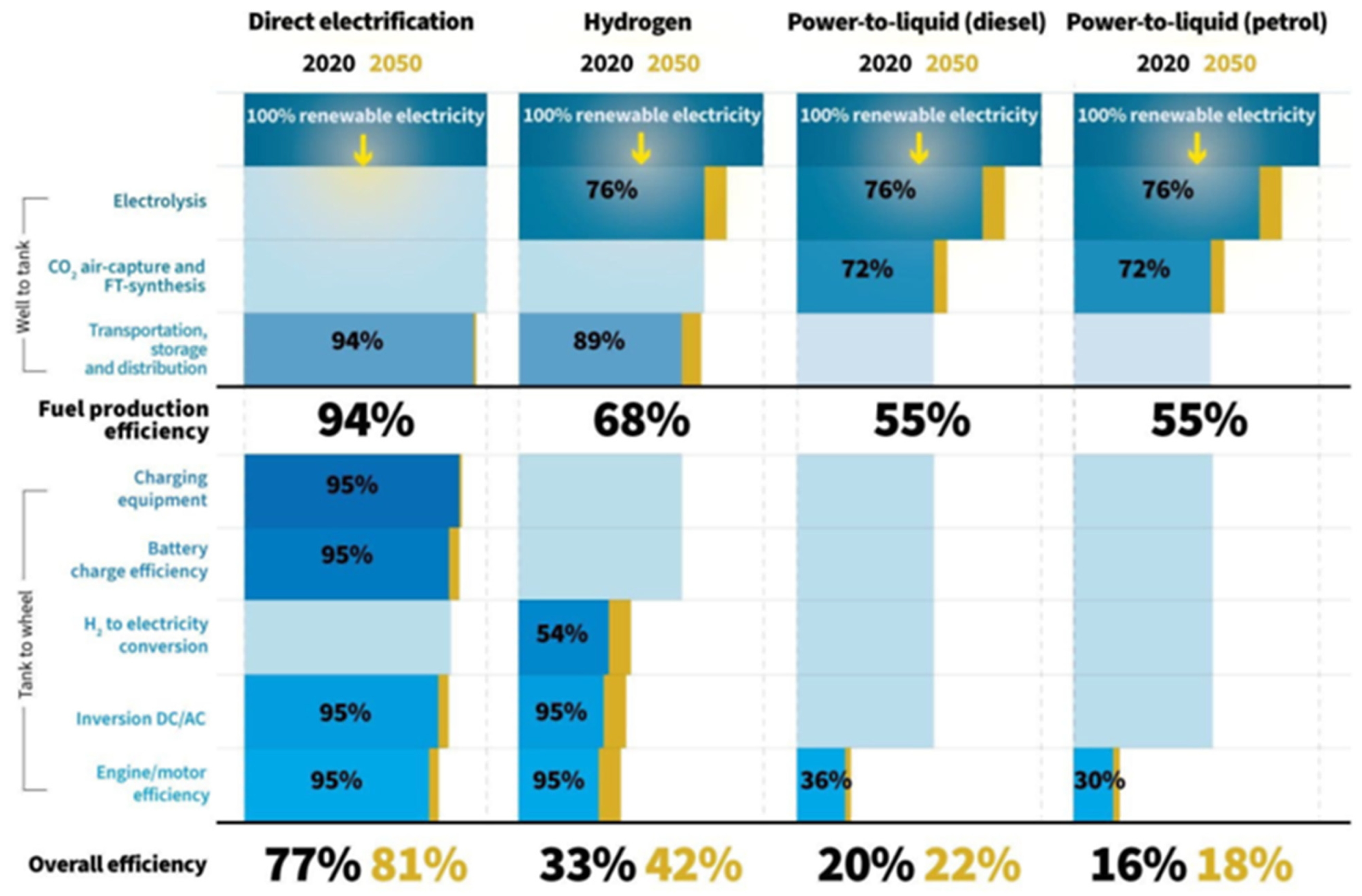





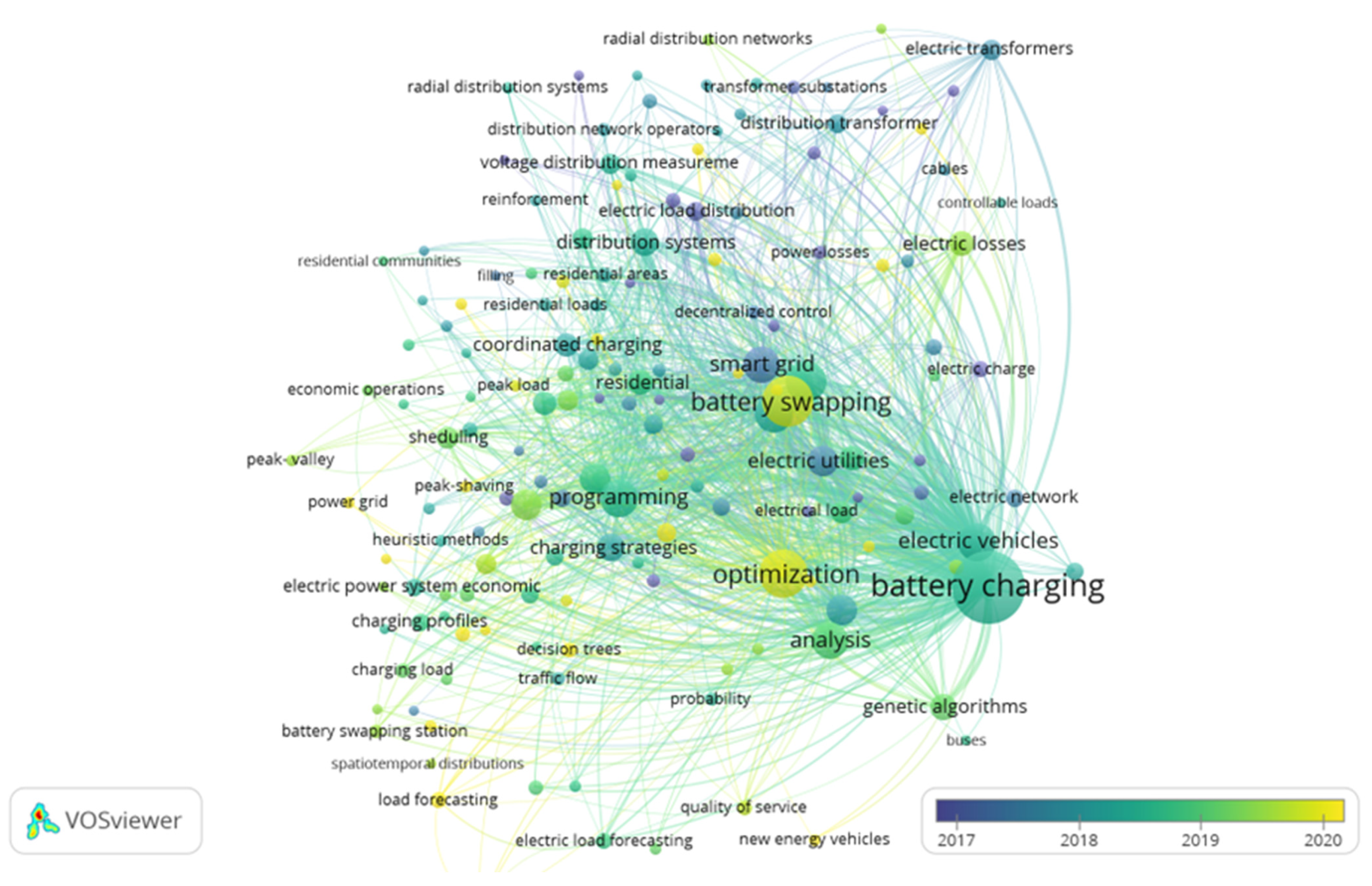
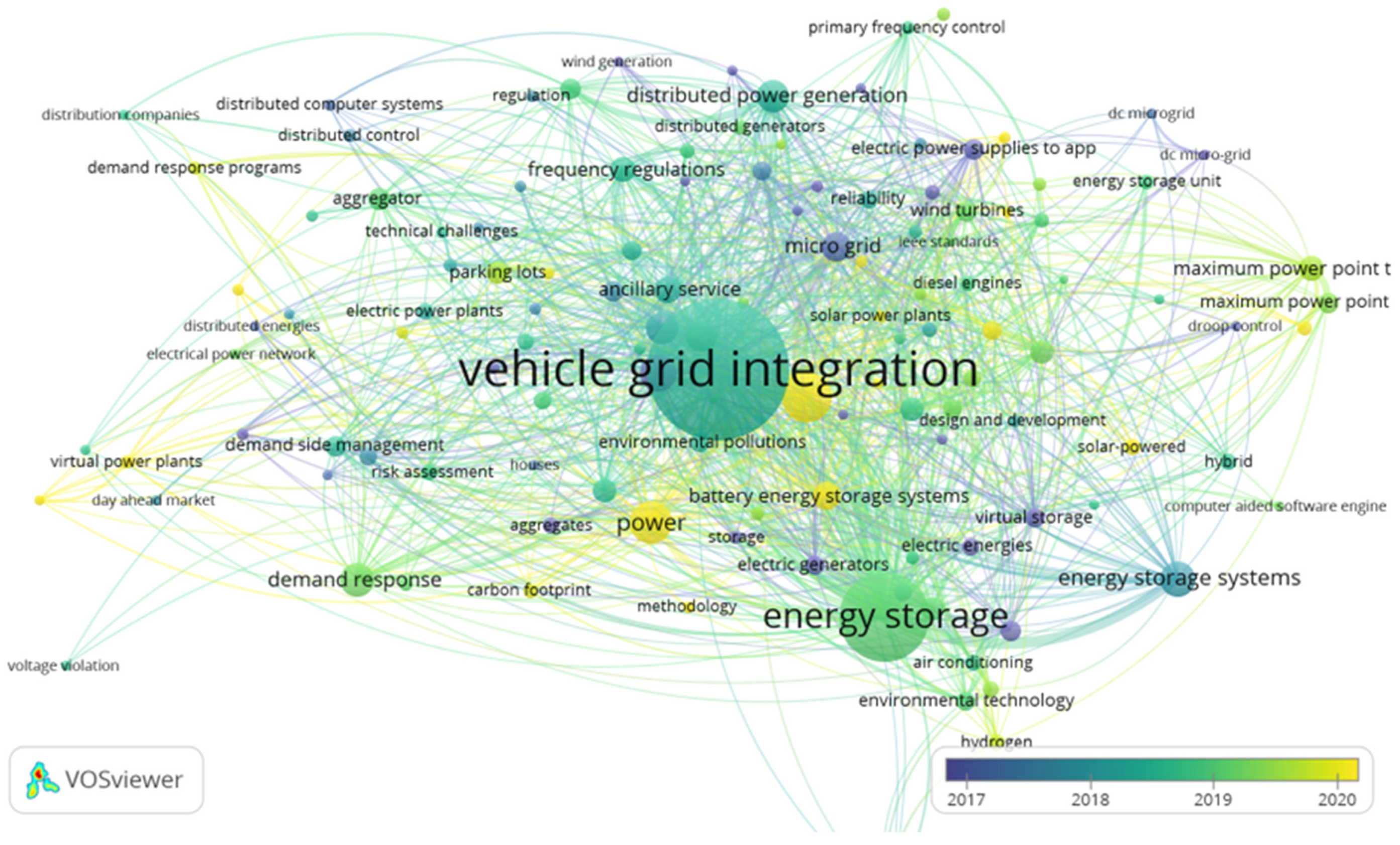
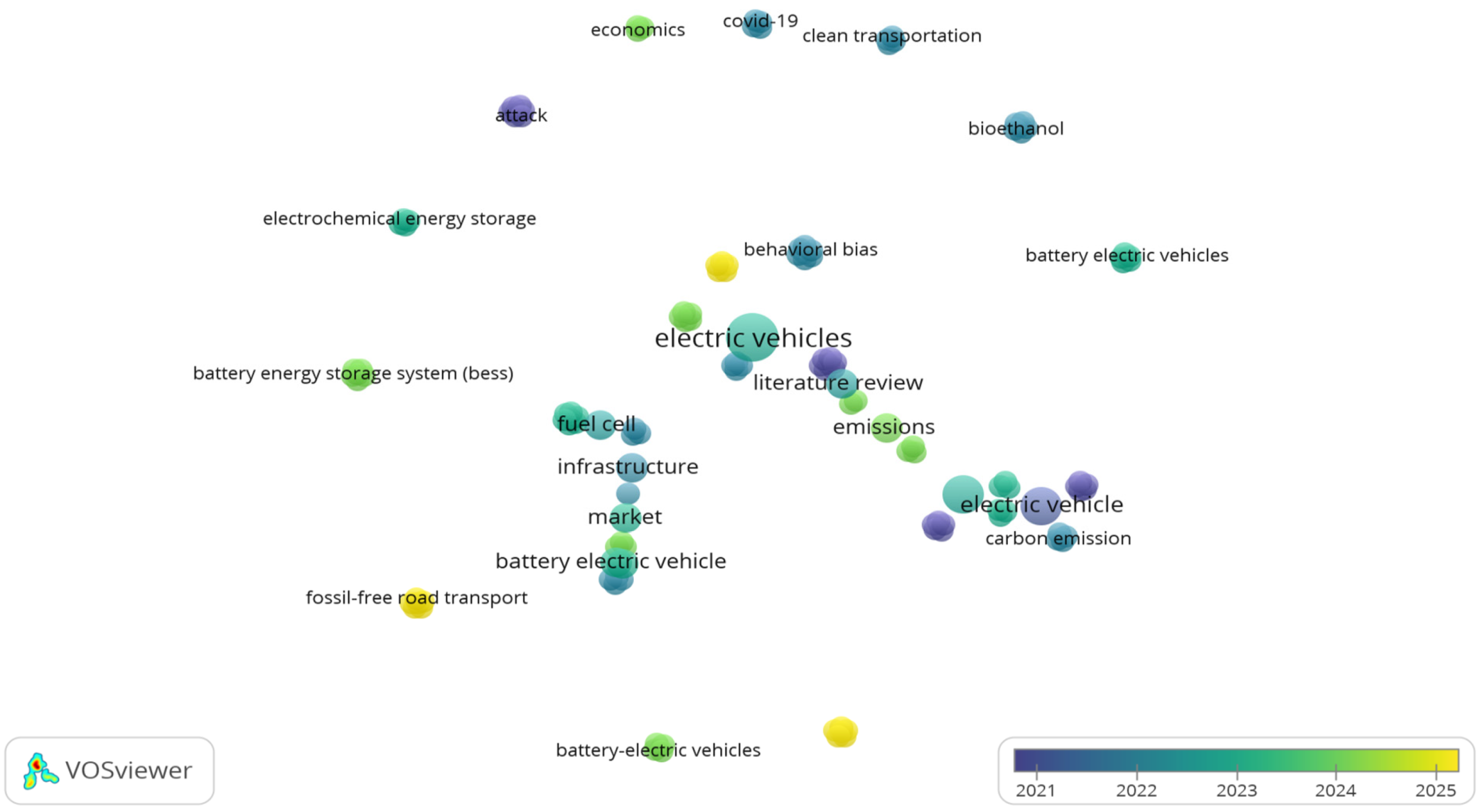

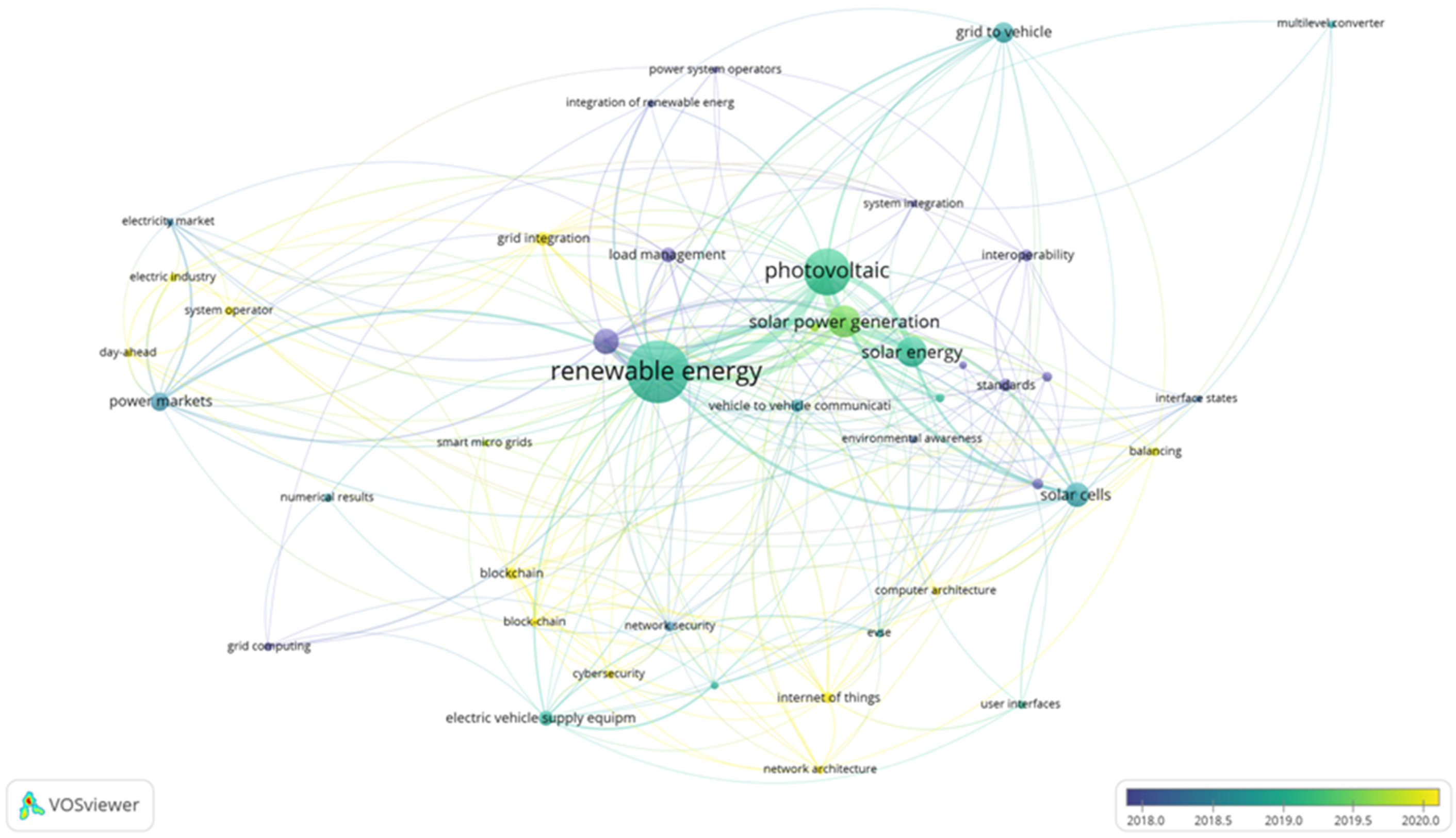
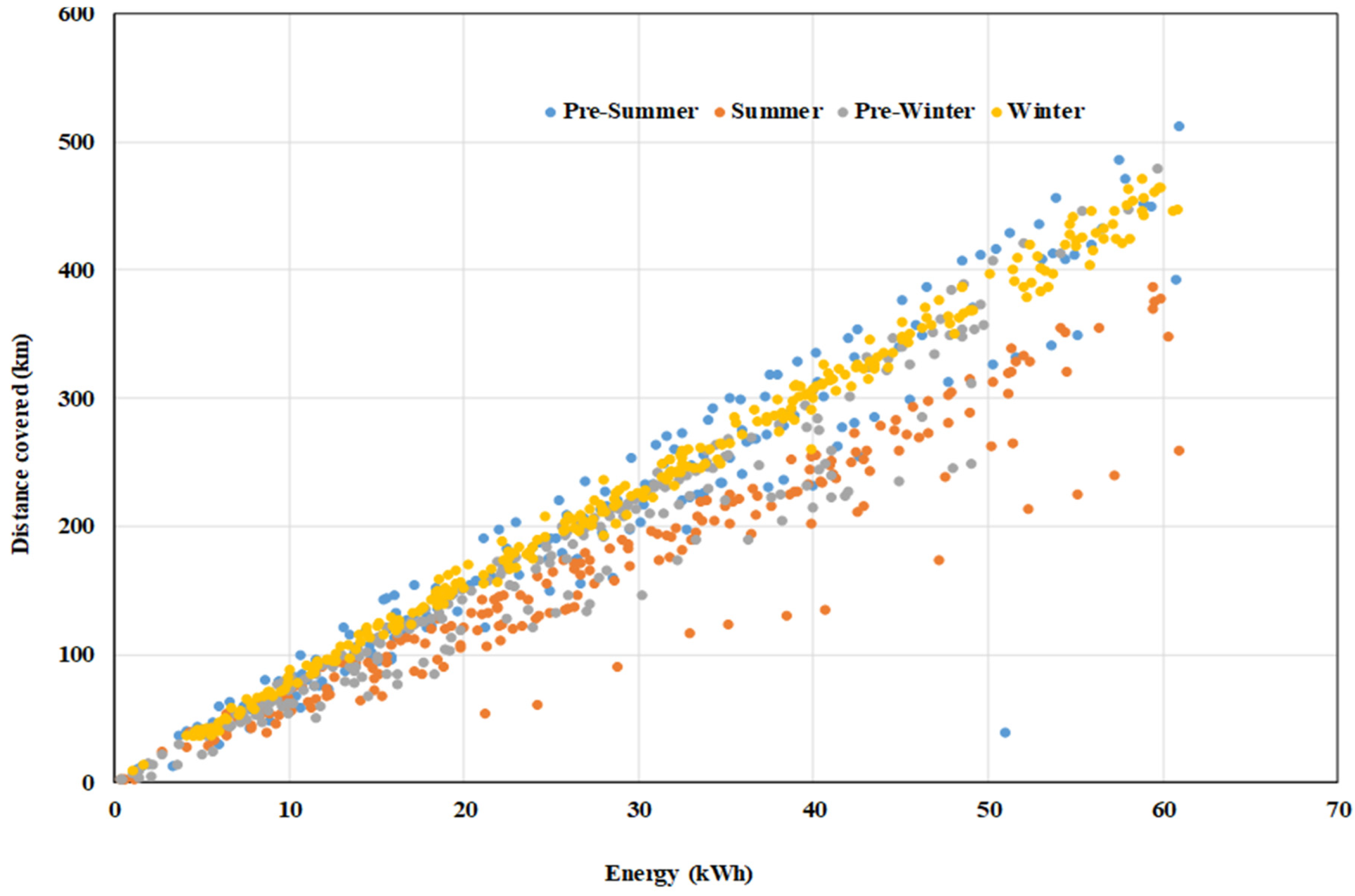


| Publisher | No. of Articles |
|---|---|
| Elsevier | 229 |
| Springer | 180 |
| MDPI | 174 |
| University of Idaho Library | 144 |
| Frontiers Media S.A. | 69 |
| Institute of Electrical and Electronics Engineers Inc. | 60 |
| Emerald Group Holdings Ltd. | 57 |
| IOP Publishing Ltd. | 42 |
| Taylor and Francis Ltd. | 41 |
| Routledge | 38 |
| SAGE Publications | 37 |
| John Wiley and Sons Inc | 27 |
| BioMed Central Ltd. | 26 |
| Dove Medical Press Ltd. | 21 |
| Hindawi Limited | 19 |
| Others | 664 |
| Options | Selected Option | Explanation |
|---|---|---|
| Type of data | Map based on bibliographic data | To determine co-occurrences |
| Data source | Reference manager file | Exported information from Scopus in .ris format and merged into one file |
| Type and unit of analysis | Occurrence | This gives us a clear idea of the interlinkages among different keywords. |
| Counting method | Fractional | |
| Use of a thesaurus file | Yes | Used in phase 2 of the analysis |
| Number of occurrences of the keyword | 5 | When the number of occurrences of keywords increases, the number of keywords in the results will be reduced; five is the default value assigned by the software. |
| Number of keywords | 2055 in the first phase and 1000 in the second phase | By merging similar words, the total number of keywords was reduced to 1000. |
| Old Keyword | New Keyword |
|---|---|
| wireless charging system renewable energy resources | wireless charging renewable energy |
| Cluster Number | Most Significant Keywords | Other Major Keywords |
|---|---|---|
| 1 | Charging station | Emissions, Cost, Crashworthiness, Sustainable development |
| 2 | Battery management system | Energy management, Programming, Prediction |
| 3 | Battery swapping | Charging optimization, Electrical network, Simulation, Scheduling |
| 4 | Vehicle–grid integration | Vehicle to grid, Grid to vehicle, Vehicle to vehicle |
| 5 | Wireless charging | Converter, Power electronics, Inductive power transfer |
| 6 | Renewable energy | Solar energy, Wind energy, Grid integration |
| Cluster | Kuwaiti Non-Adoption Factor(s) Addressed (IDs from Section 4) | Policy Lever(s) |
|---|---|---|
| 1. Charging stations | (1) Lack of 300–500 kW DC fast charging (DCFC); (9) weak enforcement of EV-only bays | Phase-1 DCFC spine (airport CBD–ring road) with shaded PV carports; enforce EV-only parking and anti-ICEing rules |
| 2. Battery management systems | (5) Skepticism about battery durability in extreme heat | Heat-soak certification (≥70 °C under-car), longer battery warranties, dealer demo data for summer range |
| 3. Battery swapping | (1) DCFC scarcity; (7) Dealers’ low EV service capacity | Taxi-fleet swap pilot; standardized under-floor packs; off-board cooled charging depots |
| 4. Vehicle–grid integration | (3) Flat subsidized tariffs reduce smart-charging/V2G value | Time-of-use tariff pilot at public DC hubs; small V2G buy-back rate; aggregator rules |
| 5. Wireless charging | (8) Oversized speedbumps and dust ingress risks | IP68 pad/enclosure standard; pad sitting and ramp-height spec for EV bays; maintenance schedule for filters |
| 6. Renewable energy | (10) Low environmental salience among policymakers/public | PV-carport program at malls/bus depots; visible generation dashboards; corporate PPAs for charger hubs |
| Model No | Range (Km) | Energy Consumption (Wh/km) | Battery (kWh) |
|---|---|---|---|
| Chevrolet Bolt | 383 | 156.6 | 60 |
Disclaimer/Publisher’s Note: The statements, opinions and data contained in all publications are solely those of the individual author(s) and contributor(s) and not of MDPI and/or the editor(s). MDPI and/or the editor(s) disclaim responsibility for any injury to people or property resulting from any ideas, methods, instructions or products referred to in the content. |
© 2025 by the authors. Published by MDPI on behalf of the World Electric Vehicle Association. Licensee MDPI, Basel, Switzerland. This article is an open access article distributed under the terms and conditions of the Creative Commons Attribution (CC BY) license (https://creativecommons.org/licenses/by/4.0/).
Share and Cite
Hamwi, H.; Ottesen, A.; Alasseri, R.; Aldei, S. A Bibliometric Analysis of the Research on Electromobility and Its Implications for Kuwait. World Electr. Veh. J. 2025, 16, 458. https://doi.org/10.3390/wevj16080458
Hamwi H, Ottesen A, Alasseri R, Aldei S. A Bibliometric Analysis of the Research on Electromobility and Its Implications for Kuwait. World Electric Vehicle Journal. 2025; 16(8):458. https://doi.org/10.3390/wevj16080458
Chicago/Turabian StyleHamwi, Hidab, Andri Ottesen, Rajeev Alasseri, and Sara Aldei. 2025. "A Bibliometric Analysis of the Research on Electromobility and Its Implications for Kuwait" World Electric Vehicle Journal 16, no. 8: 458. https://doi.org/10.3390/wevj16080458
APA StyleHamwi, H., Ottesen, A., Alasseri, R., & Aldei, S. (2025). A Bibliometric Analysis of the Research on Electromobility and Its Implications for Kuwait. World Electric Vehicle Journal, 16(8), 458. https://doi.org/10.3390/wevj16080458





